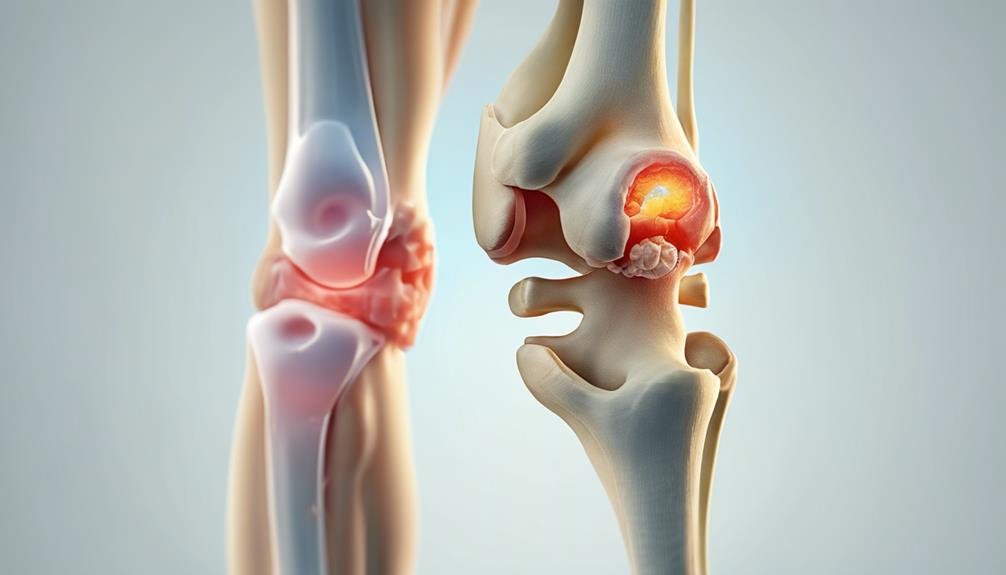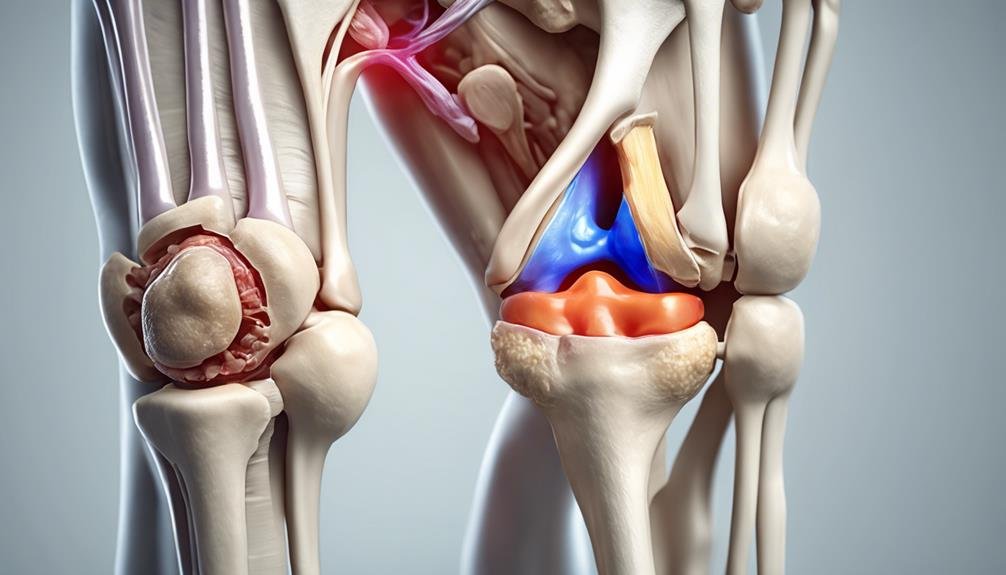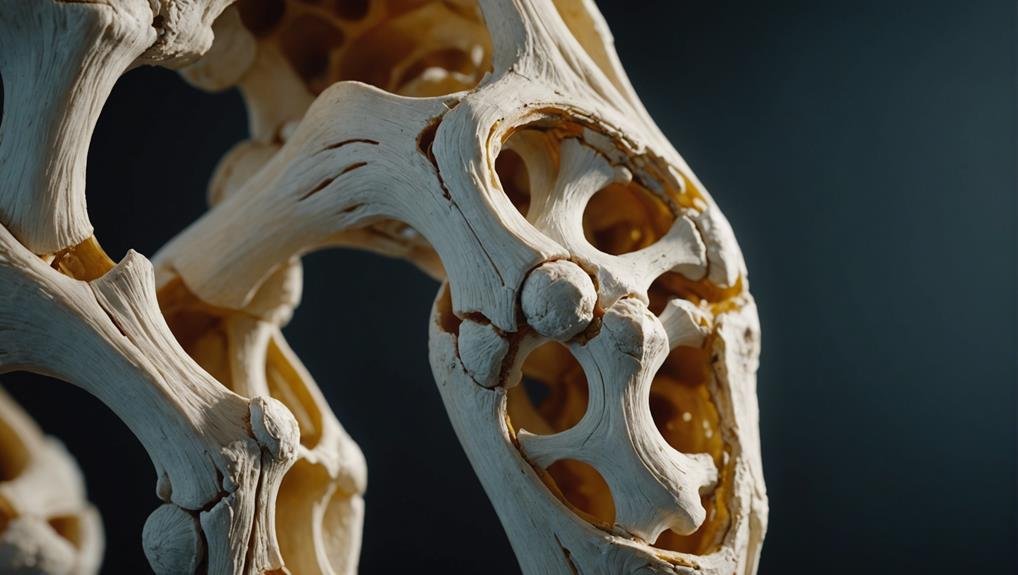When you hear about tri-compartmental osteoarthritis, it’s important to understand that it affects all three knee joint compartments, leading to significant wear and tear. You might experience persistent knee pain, swelling, stiffness, and a limited range of motion. These symptoms often stem from factors like aging, joint injuries, obesity, and genetic predispositions. Diagnosing this condition typically involves a physical examination and imaging tests, but what’s the best way to manage and treat it? Let’s explore the various methods to alleviate symptoms and prevent further degeneration.
Key Takeaways
- Tricompartmental osteoarthritis affects all three knee joint compartments, leading to extensive wear and tear.
- Symptoms include persistent knee pain, swelling, stiffness, and limited range of motion.
- Risk factors are age, obesity, joint injuries, and genetic predispositions.
- Diagnosis involves physical exams, X-rays, MRI scans, and joint fluid analysis.
- Treatment options range from conservative measures to knee replacement surgery.
Understanding Tricompartmental Osteoarthritis

Understanding tri-compartmental osteoarthritis starts with knowing that it affects all three compartments of your knee joint: the medial, lateral, and patellofemoral areas. This type of osteoarthritis leads to extensive wear and tear, causing significant discomfort and mobility issues.
To diagnose tricompartmental osteoarthritis, your doctor will perform a thorough physical examination and may order imaging tests like X-rays or MRI scans. These tests help visualize the extent of the joint damage. In some cases, joint fluid analysis can provide additional insights.
Several risk factors increase the likelihood of developing tri-compartmental osteoarthritis. Age is a major factor, as the condition is more common in older adults. Previous joint injuries, obesity, and genetic predispositions also contribute to the risk.
You have a range of treatment options. Conservative measures include medications to manage pain and inflammation and physical therapy to strengthen the muscles around your knee joint.
If these measures aren’t effective, your doctor might suggest surgical interventions. One of the most common procedures is knee replacement surgery, which aims to restore function and alleviate pain by replacing the damaged parts of the knee with artificial components.
Common Symptoms
When dealing with tri-compartmental osteoarthritis, you’ll often notice persistent knee pain that gradually worsens over time. This kind of arthritis affects all three knee joint knee joint compartments, leading to significant discomfort.
The pain often originates due to the wearing away of cartilage, the cushiony material that helps your bones move smoothly against each other. As the cartilage deteriorates, the bones start to grind together, causing that characteristic pain and sometimes a grinding sensation known as crepitus.
Swelling in the knee joint is common, and you may feel stiff, especially after periods of inactivity. This stiffness can limit your range of motion, making it hard to bend or straighten your knee fully. Weight-bearing activities like climbing stairs or walking can become increasingly difficult as the arthritis progresses.
Weakness in the knee can also develop, affecting one’s ability to perform everyday tasks. One might notice changes in one’s gait as one unconsciously adjusts one’s walking pattern to minimize pain.
In severe cases, tricompartmental osteoarthritis can lead to deformity and instability in the knee joint, making it essential to seek medical help for proper management.
Causes and Risk Factors

Aging is the most common cause of tri-compartmental osteoarthritis, and its prevalence increases notably in older adults. As you age, the wear and tear on your joints accumulate, leading to this condition.
Obesity also plays an important role, as the extra weight puts additional joint stress on your knees, accelerating cartilage breakdown.
Moreover, genetic factors can influence your susceptibility to tri-compartmental osteoarthritis. If your family has a history of the condition, you’re at a higher risk.
Joint overuse and repetitive stress, often due to certain physical activities or occupations, can exacerbate the wear on your knee joints. Previous injuries, especially traumatic injuries like fractures or ligament tears, can weaken the joint and make it more prone to arthritis.
Anatomical features, such as misaligned bones or abnormal joint shapes, can also contribute to the development of the condition. These features may cause uneven stress distribution across the joint, leading to faster degeneration.
Knowing these causes and risk factors can help you take preventive measures and seek early intervention. Understanding what puts you at risk is the first step in effectively managing tri-compartmental osteoarthritis.
Diagnostic Methods
To diagnose tricompartmental osteoarthritis, doctors rely on a combination of physical exams and imaging tests. During the physical exam, your doctor will assess joint function and range of motion. They’ll likely ask you to move your knee in various directions to identify pain points and check for any swelling or tenderness.
Imaging tests are essential in diagnosing tri-compartmental osteoarthritis. X-rays are commonly used to visualize joint damage and determine the severity of osteoarthritis. They can highlight the narrowing of joint spaces and the presence of bone spurs.
MRI scans are employed for more detailed images. These scans provide a detailed view of the knee joint, making it easier to identify cartilage loss and other structural changes that X-rays might miss.
Additionally, your doctor may recommend joint fluid analysis to check for inflammation and rule out other causes of knee pain, like infections or gout. Blood tests can also be useful, as they help detect markers of inflammation or joint damage associated with tricompartmental osteoarthritis.
Together, these diagnostic methods give a complete picture of your condition, allowing for a more accurate diagnosis and tailored treatment plan.
Treatment Options

Once diagnosed with tri-compartmental osteoarthritis, you have various treatment options to help manage the condition and improve your quality of life. One of the first steps is weight management, which can greatly reduce the stress on your knee joints.
Physical therapy is another vital component, helping you build strength and flexibility through targeted exercises.
Pain relief medications, such as NSAIDs, can alleviate discomfort, while injections, like corticosteroids, offer more immediate relief for inflammation. In severe cases, knee replacement surgery might be necessary to restore function and reduce pain.
Lifestyle modifications are essential. Incorporating low-impact exercises like swimming or cycling can keep you active without putting too much strain on your joints. Joint protection techniques, like using proper body mechanics and avoiding repetitive stress, can also significantly impact.
Assistive devices, such as insoles or knee braces, can provide additional support and improve mobility.
Regular monitoring and follow-up with your healthcare provider ensure that your treatment plan remains effective and can be adjusted as needed.
Prevention Strategies
Preventing tri-compartmental osteoarthritis involves maintaining a healthy weight and engaging in low-impact exercises to reduce knee joint stress. Weight management is vital because excess weight stresses your knee joints. Adopting low-impact exercises like swimming or cycling can strengthen muscles around your knee and enhance joint health.
Proper footwear and joint protection techniques during physical activities can greatly reduce the risk of developing tri-compartmental osteoarthritis. Avoiding high-impact activities that strain your knees, such as running on hard surfaces, is also important to prevent further joint damage.
Early detection and regular monitoring of knee pain or discomfort are essential. Addressing any issues promptly can help in the prevention of tri-compartmental osteoarthritis. Here’s a quick reference table to help you remember these key strategies:
| Prevention Strategy | Description |
|---|---|
| Weight Management | Maintain a healthy weight to reduce knee joint stress |
| Low-Impact Exercises | Engage in activities like swimming or cycling to strengthen muscles |
| Joint Protection Techniques | Use proper footwear and protective methods during physical activities |
| Avoid High-Impact Activities | Steer clear of exercises that strain your knees, like running. |
Focus on these strategies to help decrease joint damage and maintain knee health.
Conclusion
Managing tri-compartmental osteoarthritis doesn’t have to be overwhelming. By understanding the symptoms and risk factors, you can take proactive steps to manage your condition effectively.
Early diagnosis and treatment options—from weight management to physical therapy or knee replacement surgery—can help you maintain a good quality of life.
Always consult your healthcare provider to tailor your treatment plan to prevent further degeneration. Stay proactive and stay informed!
FAQs
What is tri-compartmental osteoarthritis?
Tricompartmental osteoarthritis is a type of osteoarthritis that affects all three compartments of the knee: the medial (inside), lateral (outside), and patellofemoral (front) compartments. This condition involves the wearing down of the cartilage that cushions the bones in these compartments, leading to pain, stiffness, and reduced mobility. Tricompartmental osteoarthritis is a more advanced and severe form of knee osteoarthritis than when only one or two compartments are affected.
What are the symptoms of tricompartmental osteoarthritis?
The symptoms of tricompartmental osteoarthritis can vary in severity but commonly include:
- Knee Pain:
- Description: Persistent pain in the knee that worsens with activity, such as walking, climbing stairs, or standing for long periods. Pain may also occur during rest or at night.
- Stiffness:
- Description: Stiffness in the knee, especially after periods of inactivity, such as first thing in the morning or after sitting for a while.
- Swelling:
- Description: Swelling in the knee joint may be accompanied by warmth and redness. This is often due to inflammation within the joint.
- Reduced Range of Motion:
- Description: Difficulty moving the knee fully, such as bending or straightening the leg. This can affect daily activities like walking, squatting, or kneeling.
- Joint Deformity:
- Description: In more advanced cases, the knee may develop a visible deformity, such as bowing in or out, due to uneven cartilage wear.
- Crepitus:
- Description: A grating or grinding sensation when moving the knee is caused by the rough surfaces of the bones rubbing together as the cartilage wears away.
What causes tri-compartmental osteoarthritis?
Tri-compartmental osteoarthritis can be caused by a combination of factors, including:
- Age:
- Cause: The risk of developing osteoarthritis increases with age as the cartilage naturally wears down over time.
- Joint Injury:
- Cause: Previous knee injuries, such as fractures, ligament tears, or meniscal damage, can increase the likelihood of developing osteoarthritis.
- Obesity:
- Cause: Excess body weight puts additional stress on the knee joints, accelerating cartilage breakdown and leading to osteoarthritis.
- Genetics:
- Cause: A family history of osteoarthritis may increase your risk, as genetic factors can influence the integrity of joint cartilage and the body’s ability to repair it.
- Repetitive Stress:
- Cause: Jobs or activities that involve repetitive knee movements, heavy lifting, or high-impact sports can contribute to the development of osteoarthritis.
- Inflammation:
- Cause: Chronic inflammation, such as from autoimmune diseases like rheumatoid arthritis, can damage cartilage and lead to osteoarthritis.
How is tri-compartmental osteoarthritis diagnosed?
Diagnosing tri-compartmental osteoarthritis typically involves:
- Medical History and Physical Examination:
- Process: Your doctor will ask about your symptoms, medical history, and any previous injuries. They will also perform a physical examination to assess the knee’s range of motion, swelling, tenderness, and alignment.
- Imaging Tests:
- They commonly confirm the diagnosis by showing joint space narrowing, bone spurs, and other signs of osteoarthritis.
- MRI: In some cases, an MRI may be ordered to provide a more detailed view of the cartilage, menisci, and other soft tissues in the knee.
- Lab Tests:
- Process: Although not always necessary, blood tests or joint fluid analysis may be performed to rule out other causes of knee pain, such as rheumatoid arthritis or infection.
What are the treatment options for tricompartmental osteoarthritis?
Treatment for tricompartmental osteoarthritis focuses on relieving symptoms, improving knee function, and slowing disease progression. Options include:
- Lifestyle Modifications:
- Weight Management: Losing weight can reduce the stress on your knees and slow the progression of osteoarthritis.
- Activity Modification: Avoiding activities that exacerbate knee pain and incorporating low-impact exercises like swimming or cycling can help maintain mobility without worsening symptoms.
- Physical Therapy:
- Exercise Program: A physical therapist can design a specific exercise program to strengthen the muscles around the knee, improve flexibility, and reduce pain.
- Assistive Devices: Braces, orthotics, or walking aids may be recommended to support the knee and reduce strain during daily activities.
- Medications:
- Pain Relievers: Over-the-counter pain relievers like acetaminophen or NSAIDs (e.g., ibuprofen) can help manage pain and inflammation.
- Corticosteroid Injections: Injections of corticosteroids directly into the knee joint can temporarily relieve pain and inflammation.
- Surgical Options:
- Total Knee Replacement: A total knee replacement (arthroplasty) may be necessary in severe cases. This procedure involves removing and replacing the damaged joint surfaces with artificial components.
- Osteotomy: This surgical procedure involves cutting and reshaping the bones to relieve pressure on the knee joint and improve alignment.
- Arthroscopy: In some cases, arthroscopic surgery may remove loose cartilage, repair damaged tissue, or smooth the joint surfaces.
- Alternative Therapies:
- Supplements: Some people find relief from osteoarthritis symptoms with supplements like glucosamine and chondroitin, although the effectiveness varies.
- Acupuncture: Acupuncture may help reduce pain and improve knee function for some individuals with osteoarthritis.
Can tri-compartmental osteoarthritis be prevented?
While it may not be possible to prevent tri-compartmental osteoarthritis completely, certain steps can reduce your risk or slow its progression:
- Maintain a Healthy Weight:
- Tip: Keeping your weight within a healthy range reduces the stress on your knees and lowers the risk of developing osteoarthritis.
- Stay Active:
- Tip: Regular exercise, especially low-impact activities like swimming, cycling, or walking, helps maintain joint health and muscle strength.
- Protect Your Joints:
- Tip: Avoiding repetitive strain and high-impact activities, using proper lifting techniques, and wearing supportive footwear can help protect your knees.
- Manage Chronic Conditions:
- Tip: If you have a condition like rheumatoid arthritis or diabetes, work with your healthcare provider to manage it effectively, as these conditions can contribute to osteoarthritis.
- Early Intervention:
- Tip: If you experience knee pain or other symptoms of osteoarthritis, seek medical advice early. Early diagnosis and treatment can help slow the progression of the disease.
Understanding tricompartmental osteoarthritis and the available treatment options can help you manage this condition effectively and maintain a better quality of life. If you suspect you have this condition, consult a healthcare professional for a proper diagnosis and personalized treatment plan.

